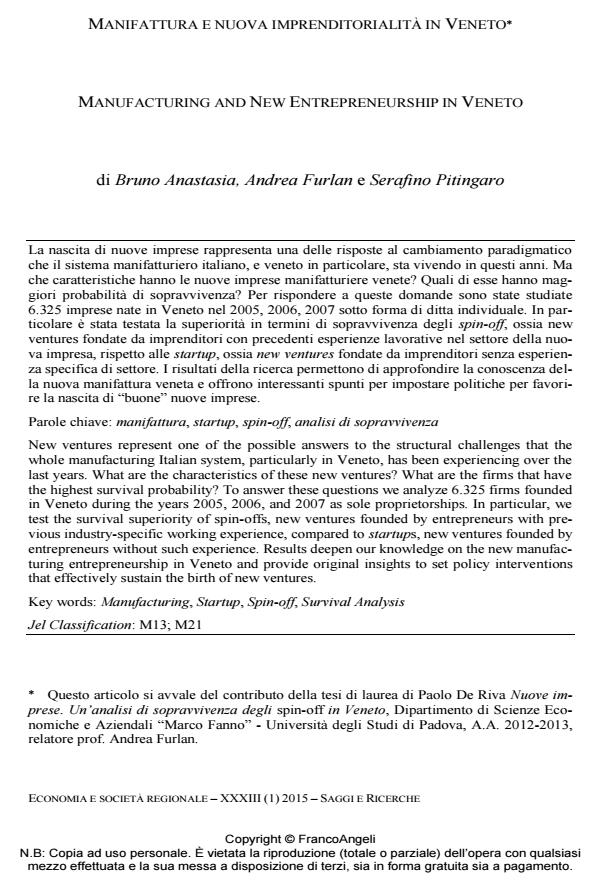Manufacturing and new entrepreneurship in veneto
Journal title ECONOMIA E SOCIETÀ REGIONALE
Author/s Anastasia Bruno, Andrea Furlan, Serafino Pitingaro
Publishing Year 2015 Issue 2015/1 Language Italian
Pages 23 P. 102-124 File size 308 KB
DOI 10.3280/ES2015-001009
DOI is like a bar code for intellectual property: to have more infomation
click here
Below, you can see the article first page
If you want to buy this article in PDF format, you can do it, following the instructions to buy download credits

FrancoAngeli is member of Publishers International Linking Association, Inc (PILA), a not-for-profit association which run the CrossRef service enabling links to and from online scholarly content.
New ventures represent one of the possible answers to the structural challenges that the whole manufacturing Italian system, particularly in Veneto, has been experiencing over the last years. What are the characteristics of these new ventures? What are the firms that have the highest survival probability? To answer these questions we analyze 6.325 firms founded in Veneto during the years 2005, 2006, and 2007 as sole proprietorships. In particular, we test the survival superiority of spin-offs, new ventures founded by entrepreneurs with previous industry-specific working experience, compared to startups, new ventures founded by entrepreneurs without such experience. Results deepen our knowledge on the new manufacturing entrepreneurship in Veneto and provide original insights to set policy interventions that effectively sustain the birth of new ventures.
Keywords: Manufacturing, Startup, Spin-off, Survival Analysis
Jel codes: M13; M21
- Agarwal R., Echambi R., Franco A.M. e Sarkar M. (2004). Knowledge transfer through inheritance: Spinout generation, development, and survival. Academy of Management Journal, 47(4): 501-522, DOI: 10.2307/20159599
- Anastasia B. e Occari F. (2012). La “creazione” di nuove imprese: note su alcune questioni di misura e di merito. Economia e società regionale,116(2): 105-110, DOI: 10.3280/ES2012-002009
- Boyer T. e Bòazy R. (2013). Born to be alive: the servival of innovative and noninnovative French micro-strat-ups. Small Business Economics, 42: 669-683, DOI: 10.1007/s11187-013-9522-8
- Brüdel J., Preisendörfer P. e Ziegler R. (1992). Survival chances of newly founded business organizations. American Sociological Review, 57(2): 227-242, DOI: 10.2307/2096207
- Carroll G.R. e Hannan M.T. (2000). The Demography of Corporations and Industries. Princeton (NJ): Princeton Press.
- Cooper A.C., Woo C. e Dunkelberg W.C. (1989). Entrepreneurship and initial size of the firm. Journal of Business Venturing, 4: 317-32, DOI: 10.1016/0883-9026(89)90004-9
- Dahl M.S. e Reichstein T. (2007). Are you experienced? Prior experience and the survival of new organizations. Industry and Innovation, 14(5): 497-511, DOI: 10.1080/13662710701711414
- Delmar F. e Shane S. (2006). Does experience matter? The effect of founding team experience on the survival and sales of newly founded ventures. Strategic Organization, 4(3): 215-247, DOI: 10.1177/1476127006066596
- Dencker J.C., Marc G. e Sonali K.S. (2009). Pre-Entry Knowledge, Learning, and the Survival of New Firms. Organization Science, 20(3): 516-53, DOI: 10.1287/orsc.1080.0387
- Di Maria E. e De Marchi V. (2008). Immigrazione ed imprenditorialità in Veneto. Mestre: Veneto Lavoro.
- Eriksson T. e Kuhn J.M. (2006). Firm spin-offs in Denmark, 1981-2000 – Patterns of entry and exit. International Journal of Industrial Organization, 24: 1021-1040, DOI: 10.1016/j.ijindorg.2005.11.008
- Folta T.B., Delmar F. e Melillo F. (2012). Endogeneity in Startup Size. Selection Effects among Types of Entrants. Working Paper. Academy of Management Proceedings, DOI: 10.5465/AMBPP.2012.231
- Folta T.B., Delmar F. e Wennberg K. (2010). Hybrid Entrepreneurship. Management Science, 56(2): 253-269, DOI: 10.1287/mnsc.1090.1094
- Furlan A. e Grandinetti R. (2012). La sopravvivenza delle nuove imprese: un’indagine in Veneto. Economia e società regionale, 115(1): 88-100, DOI: 10.3280/ES2012-001005
- Furlan A. e Grandinetti R. (2014). Spinoff performance in the startup phase: A conceptual framework. Journal of Small Business and Enterprise Development, 21(3): 528-544, DOI: 10.1108/JSBED-04-2014-0055
- Furlan A., Grandinetti R. e Camuffo A. (2007a). How do Subcontractors Evolve?. International Journal of Operations and Production Management, 27(1): 69-89, DOI: 10.1108/01443570710714547
- Furlan A., Romano V., Camuffo A. e Vinelli A. (2007b). Routes Towards Supplier and Production Network Internationalization. International Journal of Operations and Production Management, 27(4): 371-387, DOI: 10.1108/01443570710736967
- Geroski P.A. (1995). What do we know about entry?. International Journal of Industrial Organization, 13: 421-440, DOI: 10.1016/0167-7187(95)00498-X
- Geroski P.A., Mata J. e Portugal P. (2010). Founding conditions and the survival of new firms. Strategic Management Journal, 31: 510-529, DOI: 10.1002/smj.823
- Gimeno J., Folta T., Cooper A. e Woo C. (1997). Survival of the fittest? Entrepreneurial human capital and the persistence of underperforming firms. Administrative Science Quarterly, 42: 750-783.
- Helfat C.E. e Lieberman M.B. (2002). The birth of capabilities: market entry and the importance of pre-history. Industrial and Corporate Change, 11(4): 725-760, DOI: 10.1093/icc/11.4.725
- Irpet (2013), a cura di. Prato. Il ruolo economico della comunità cinese. Firenze. Khessina O.M. e Carroll G.R. (2008). Product Demography of De Novo and De Alio Firms in the optical disk drive industry, 1983-1999. Organization Science, 19(1): 25-38, DOI: 10.1287/orsc.1070.0301
- Klepper S. (2001). Employee startups in high-tech industries. Industrial and Corporate Change,10(3): 639-674, DOI: 10.1093/icc/10.3.639
- Klepper S. (2007). Disagreements, Spinoffs, and the Evolution of Detroit as the Capital of the U.S. Automobile Industry. Management Science, 53(4): 616-631, DOI: 10.1287/mnsc.1060.0683
- Klepper S. (2009). Spinoffs: A review and synthesis. European Management Review, 6(3): 159-171, DOI: 10.1057/emr.2009.18.MaurielloD.,PitingaroS.eScaccabarozziS.(2012).Enterprisecreationecicl
- economico: caratteristiche e motivazioni dei neoimprenditori. Economia e società regionale, 115(1): 24.42, DOI: 10.3280/ES2012-001002
- Riva E. e Lucchini M. (2013). Demografia e sopravvivenza delle imprese straniere. In: Camera Di Commercio Di Milano - C.D.C.D.M., a cura di. Milano produttiva. 23° Rapporto della Camera di Commercio di Milano. Milano: Guerini & Associati.
- Santarelli E. e Vivarelli M. (2007). Entrepreneurship and the process of firms’ entry, survival and growth. Industrial and Corporate Change, 16(3): 455-488, DOI: 10.1093/icc/dtm010
- Stinchcombe A. L. (1965). Social structures and organizations. In: James G. March, a cura di. Handbook of Organizations. Chicago: Rand McNally: 142-193.
Anastasia Bruno, Andrea Furlan, Serafino Pitingaro, Manifattura e nuova imprenditorialità in veneto in "ECONOMIA E SOCIETÀ REGIONALE " 1/2015, pp 102-124, DOI: 10.3280/ES2015-001009